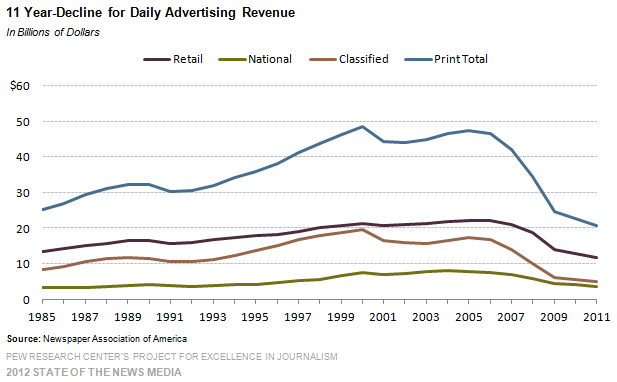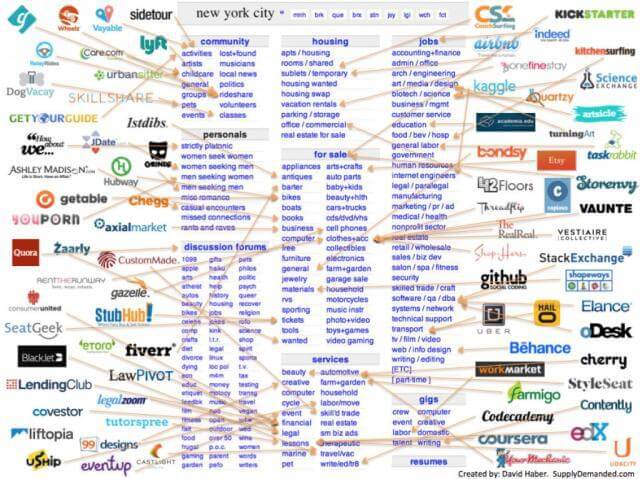Newspapers used to earn much of their revenue from classified advertising. This abruptly came to an end in the early 2000s, largely as a result of Craigslist: They captured users on the web before the newspapers had a chance to react, and their largely freemium pricing model (where a few users subsidize the many) collapsed the newspapers’ model for pricing classified ads. What was once a $20 billion business was just a decade later down to $5 billion:
It’s one of the most prominent examples of digital disruption. But as is the case with the endless cycle of tech innovation, the once-disruptor becomes the now-incumbent. And this time, the shift isn’t from print to web; it’s from PCs to mobile … and everything that comes with that. It is arguably one of the most profound tech shifts we have ever seen, because for the first time technology is outgrowing the tech industry (as my partner Benedict Evans has observed and shares here in great detail).
This mobile revolution has been driven by an explosion in smartphones. This has had a massive impact on digital consumption, with many consumer sites now reporting more usage on mobile devices than on PCs. And this in turn has completely changed people’s expectations about user experience, ease-of-use, and the desire for frictionless experiences: being able to do things “in the flow”, while they’re out and about living their lives. When we are on our phones all day, every day, we expect those kinds of experiences from everything — even things not intuitively about tech or mobile.
So where Craigslist might have led, it has changed very little to adapt to this mobile world (they still don’t even have an iOS — let alone, Android — app). Coupled with this failure to innovate is a cycle of unbundling and bundling that has created opportunities for a new set of companies to carve out segments of its business. Just a few examples from our portfolio include Airbnb for the “housing: rooms/shared” and “housing: sublets/temporary” categories; Lyft for “community: rideshare”; and YourMechanic for “services: automotive”. There are countless other examples of this unbundling happening to Craigslist, as illustrated by this classic graphic:
Yet one of the categories that has been resistant to disruption has been the “for sale” verticals — everything from bikes, boats, cars & trucks, computers, furniture, garage sale, motorcycles, musical instruments, RVs, camping equipment, baby clothes, cribs, sporting equipment, and so on. These products tend to be sold locally as it’s difficult and expensive to ship them. And frankly, it has been a lot of work to create online listings; we’d almost rather let that stuff sit and collect dust than go through the effort.
Imagine if you could just “snap and sell” these products directly from your phone. What if you could sell them not just locally, but hyperlocally: If there’s a mother whose child is just 1 year ahead of yours and therefore wants to get rid of the very items you need at that exact same time?
Co-founders Nick Huzar and Arean Van Veelen were motivated by this very problem. Frustrated by previous attempts to sell family items in order to reclaim space in their homes, they founded OfferUp to create a “simpler and more trusted way to buy and sell locally”. It’s a mobile-first marketplace that has removed much of the friction from buying and selling goods in your local market by fully leveraging the smartphone platform — everything from the camera to connectivity. OfferUp enables users to clean out their garages by literally going there with their smartphones, snapping pictures, and directly and seamlessly listing the item on OfferUp. In other words: without having to download all the photos, pull up a Word doc to craft a listing, upload all the photos and fill out forms, re-verify who you are (since your phone already knows) … and so on.
Similarly, buyers on OfferUp can shop for goods on their smartphones any place and any time. But it’s also a new kind of transaction experience.
We first invested in OfferUp in May 2014, but kept that information under wraps — at the company’s request — as they methodically rolled out to new cities. But it’s been getting harder to do this once they shot up towards the top of the “shopping” charts in the Android and iOS app stores. Now that the company has a national footprint and is starting to get lots of attention, they’ve made the decision to take the wraps off.
To date, the company has raised $90 million from Coatue Management, High Line Venture Partners, Jackson Square, T. Rowe Price, Tiger Global, Vy Capital, and Andreessen Horowitz.
We believe OfferUp has the potential to truly be a category killer — in the existing category of buying and selling goods between people locally — by providing a trustworthy and easy mobile-first experience. The breadth of goods changing hands on the platform is impressive, from baby gear to couches to cars. And the volume is equally impressive; the platform has already seen $2.9 billion in transactions this year alone.
We are proud to support Nick, Arean, and the entire OfferUp team in building this business, and in enabling consumers everywhere to be able to do more kinds of commerce with their mobile phones than ever before. Welcome to the mobile-local shopping era!





